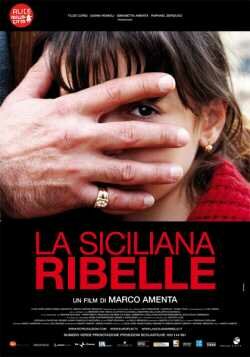Sicily’s Cosa Nostra mafia have gained a strong international profile in recent years, through films like last year’s Gomorrah and Gabriele Salvatores’ I’m Not Scared (2003). The underlying corruption in Sicilian communities still lingers past the 20th Century, bringing us a slew of films with revelations about men, family honour, politics and power. The true story of Rita Atria and her stand against injustice remains important to Sicilians as a statement that unbalanced power makes for an unstable society. While The Sicilian Girl has a more biographical lean over a showcase of mafia bloodshed, there’s still plenty of drama to go around.
Rita Atria, here known as Rita Mancuso (Veronica D’Agostino), is a lead with a difference as we’re led to wonder if her adolescent mind has been as equally corrupted as those around her. Rita’s fight for justice is documented through her diaries after the death of her father, but the discoveries she makes in the following years harden her shell, to the point where she can trust almost no-one. The subsequent use of Rita’s musings as evidence against numerous members of the Cosa Nostra endangers her life and forces her to re-evaluate her priorities. And this is all by the age of 17. It’s as much about a girl growing up as it is about true crime, as Rita learns about love and loss amidst her family dramas. A dysfunctional relationship with her mother and growing romance with Vito (Francesco Casisa) highlights the common rite-of-passage, fuelling both trust and uncertainty.
|
|
Director Marco Amenta has a large interest in Rita’s story, after first making documentary Diario di una siciliana ribelle (Diary of a Sicilian Girl, 1997) which shows her evidence in between interviews and raw footage. Over a decade later, The Sicilian Girl shows that Rita’s fight still resonates with Italian audiences and is effective in showing a dramatic situation in the almost melodramatic style that Italian film has come to know. With the minimal violence that’s actually shown, when blood is shed it’s to good effect. However, some plot points in the film’s second half appear out of left-field; Rita’s choices, while understandable given the circumstances, often seem rash. Amenta’s casting of D’Agostino as Rita is also puzzling – while she does a fine job she clearly looks older than Rita’s teenage years. But when it’s needed, The Sicilian Girl is chilling. Not just because of the true events or effective violence but because for all the smarts Rita thinks she has, someone’s always one step ahead.
Verdict:
Another Cosa Nostra tale hits international screens. The Sicilian Girl is neither the best nor the worse, but still keeps the traditional dramatic flair of Italian cinema.
The Sicilian Girl screens as part of the 2009 Lavazza Italian Film Festival, In Adelaide from Oct 14-28. For more information, visit http://www.italianfilmfestival.com.au/
 Follow the author Katina Vangopoulos on Twitter.
Follow the author Katina Vangopoulos on Twitter.






![Gomorrah [Gomorra] (Review) Gomorrah [Gomorra] (Review)](/wp-content/uploads/scena-gomorra-il-film1-150x150.jpg)
![Kiss Me Again [Baciami Ancora] (Review) Kiss Me Again [Baciami Ancora] (Review)](/wp-content/uploads/baciamiancora222-thumb1-150x150.jpg)









